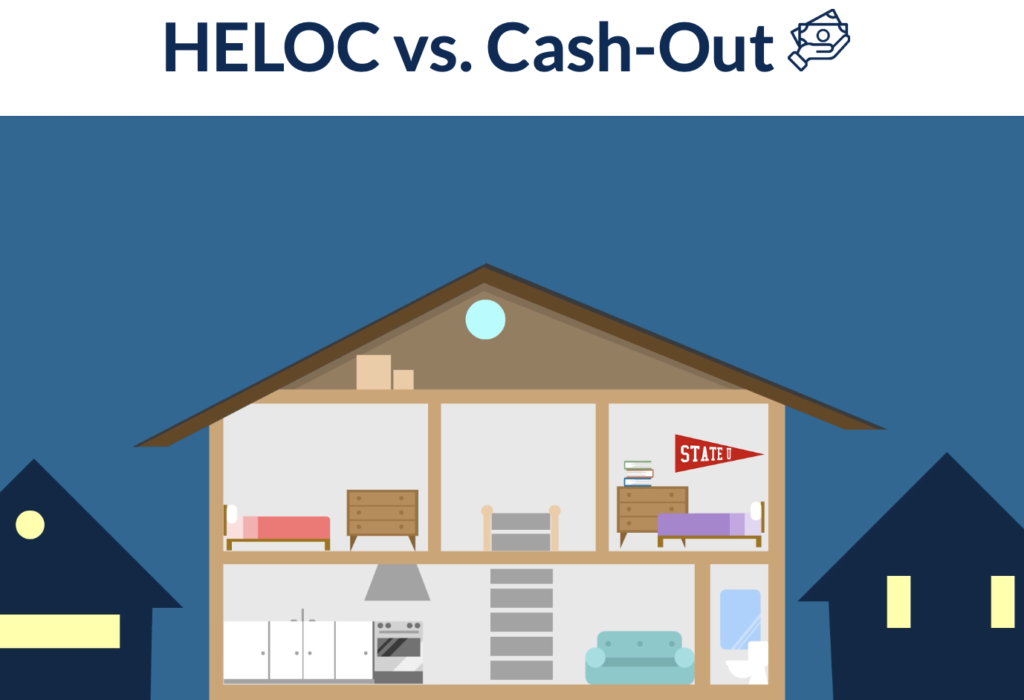Now is a great time to refinance as interest rates remain at all-time lows, and many homeowners are sitting on untapped equity. Your mortgage should change with your evolving financing needs, so if you have equity in your home and are looking for extra cash-on-hand for upcoming expenses, you may benefit from a cash-out refinance.
What is a Cash-Out Refinance?
A cash-out refinance is when you leverage the equity* in your home by replacing your existing mortgage with a higher loan amount than what you currently owe. The difference between the loan amounts is cash available to you.
*Equity is the difference between the amount owed on your mortgage and the market value of your home. Equity may increase over time as you pay down the mortgage principal, or there’s an increase in the appraised property value.
What are the Cash-Out Refinance Requirements?
Here is an overview of some of the mortgage requirements for a cash-out refinance and ways to prepare.
Loan-to-Value Ratios
Typically, mortgage companies will only allow a loan-to-value (LTV) of 80% for a cash-out refinance. However, the limits may vary depending on the desired loan terms.
Debt-to-Income Limits
The lender may require you to have a debt-to-income (DTI) ratio below 50%. A cash-out refinance can provide you with a higher loan amount than before, which will increase your DTI ratio. Focus on paying off some debt before applying for a new mortgage if your ratio is near or above 50%.
Equity Percentage
To leverage the equity in your home and take cash-out, you must have at least 20% equity in your home. Thus, if your original down payment was 10% of the home’s value, then you will have to wait until you have made enough mortgage payments to reach 20% equity before you qualify for a cash-out refinance.
How to Get Started with a Cash-Out Refinance
Determine How Much Cash You Need
You must consider how much money you need on hand before applying for the loan. The amount of cash you can take out may depend on your current mortgage balance and estimated property value.
Submit an Application & Upload Documents
Applying for a cash-out refinance is like applying for a new mortgage, so you must complete an online application. You will then be prompted to upload your updated financial information and documentation so the mortgage company can determine your eligibility for the loan.
Prepare for an Appraisal
Appraisals are often required on a cash-out refinance to evaluate the property’s market value. Click here to review how to prepare for the appraisal process.
Benefits of a Cash-Out Refinance
There are plenty of financial benefits to getting a cash-out refinance. Here are a few ways in which you can utilize the cash proceeds.
Consolidate High-Interest Debt
This is a good option for those with high-interest debt, such as credit card bills. You can put the cash towards the high-interest-bearing balance and consolidate the remaining debt into a single loan with lower interest. Paying off loans with high interest and substantial balances may help you save money in the long run. Additionally, the faster you pay off debt, the more money you will have for future savings!
Pay Off Student Loan Debt
Although some federal student loans were on hold during the pandemic, you can use the cash to pay down your student loan balance to help you work towards a debt-free life faster.
Put More Money into Retirement for Long-Term Savings
This is a good option for those who want to focus on long-term savings. Maybe you haven’t been able to save as much recently because of unexpected expenses but want to boost your retirement account and focus on long-term savings. Remember, it’s never too early to start saving!
Purchase another Property
For savvy buyers, now may be a great time to expand upon your investment portfolio. Use the funds from the cash-out refinance to invest in a second home for your family or an investment property to generate additional revenue.
Tip: If you are thinking about buying another property, consider the down payment you may need for that home. Then, you can speak with a mortgage specialist to see if you can use the cash from the refinance for a down payment on a new property.
Pay for Home Improvements & Repairs
You may be able to use the cash to pay for home renovations and repairs you’ve always wanted to accomplish, such as a bathroom renovation or kitchen upgrade. This may be an excellent option for those looking to sell their home soon, as home improvements can increase the house’s value.
Cash-Out Refinance Example & Interactive Calculator
Let’s say your home is worth $100,000, and your current mortgage balance is $50,000. That means you have $50,000 of equity in your home that you can tap into as cash. Keep in mind that you may be restricted to an LTV of 80% or less, meaning the new maximum loan amount maybe $80,000. If you apply for a cash-out refinance with a loan amount of $75,000, you will receive $25,000 in cash ($75,000 – $50,000).
Cash-Out Refinance VS. HELOC
The main difference between a HELOC and a cash-out refinance is that a HELOC is an additional mortgage, whereas a cash-out refinance replaces your current mortgage. A HELOC will require other monthly payments in addition to your monthly mortgage payments. Additionally, HELOCs typically have higher interest rates than cash-out refinances.
Some may want a HELOC over a cash-out refinance to take out cash as needed instead of getting a lump sum after closing. However, we recommend speaking with one of our mortgage specialists to determine if a HELOC or cash-out refinance is best for you.
To learn more about cash-out refinancing or to get started, contact us today!


